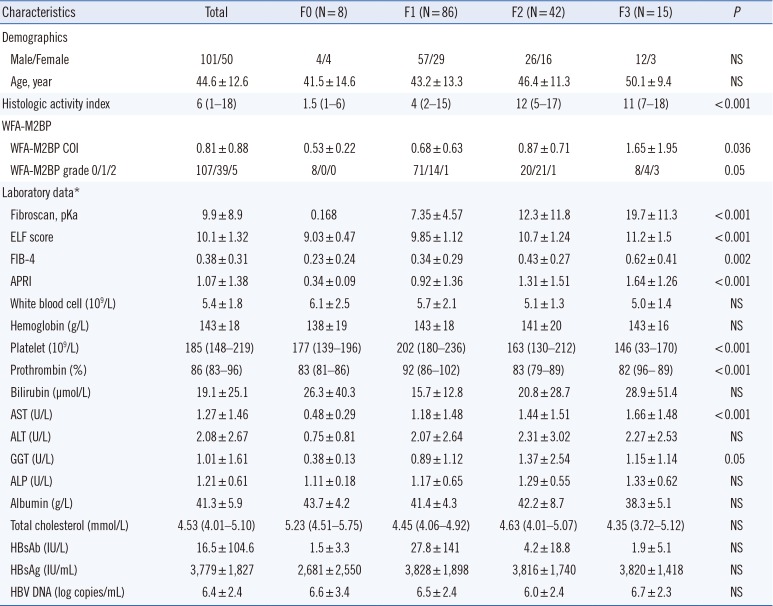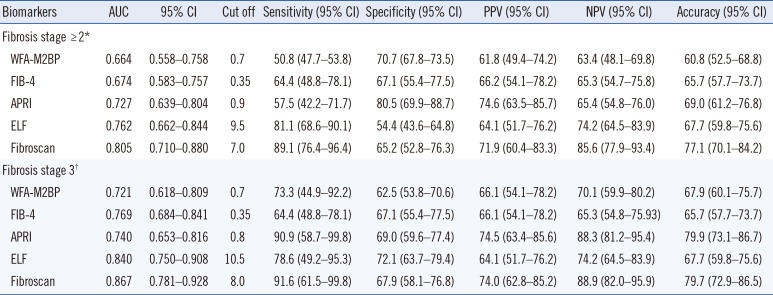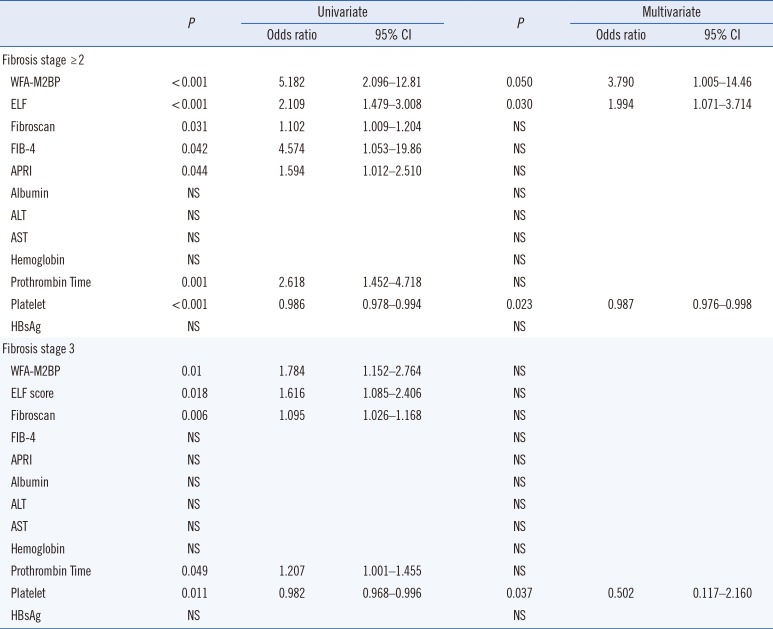1. Ge PS, Runyon B. Treatment of patients with Cirrhosis. N Engl J Med. 2016; 375:767–777. PMID:
27557303.
2. Rosenberg W, Voelker M, Thiel R, Becka M, Burt A, Schuppan D, et al. Serum markers detect the presence of liver fibrosis: a cohort study. Gastroenterology. 2004; 127:1704–1713. PMID:
15578508.
3. Ellis E, Mann D. Clinical evidence for the regression of liver fibrosis. J Hepatol. 2012; 56:1171–1180. PMID:
22245903.
4. Ahmad W, Ijaz B, Gull S, Asad S, Khaliq S, Jahan S, et al. A brief review on molecule, genetic and imaging techniques for HCV fibrosis evaluation. Virol J. 2011; 8:53–69. PMID:
21299910.
5. Castera L, Pinzani M. Biopsy and non-invasive methods for the diagnosis of liver fibrosis: does it take two to tango? Gut. 2010; 59:861–866. PMID:
20581229.
6. Jung KS, Kim SU, Ahn SH, Park YN, Kim DY, Park JY, et al. Risk assessment of hepatitis B virus-related hepatocellular carcinoma development using liver stiffness measurement (Fibroscan). Hepatology. 2011; 53:885–894. PMID:
21319193.
7. Theise N. Liver biopsy assessment in chronic viral hepatitis: a personal, practical approach. Mod Pathol. 2007; 20:S3–S14. PMID:
17486049.
8. Brunt EM. Grading and staging the histopathological lesions of chronic hepatitis: the Knodell histology activity index and beyond. Hepatology. 2000; 31:241–246. PMID:
10613753.
9. Parkes J, Guha IN, Harris S, Rosenberg W, Roderick P. Systematic review of the diagnostic performance of serum markers of liver fibrosis in alcoholic liver disease. Comp Hepatol. 2012; 11:1–20. PMID:
22524730.
10. Schuppan D, Afdhal N. Liver cirrhosis. Lancet. 2008; 371:838–851. PMID:
18328931.
11. Poynard T, Halfon P, Castera L, Munteanu M, Imbert-Bismut F, Ratzui V, et al. Standardization of ROC curve areas for diagnostic evaluation of liver fibrosis markers based on prevalences of liver fibrosis stages. Clin Chem. 2007; 53:1615–1622. PMID:
17634213.
12. Mallat A, Lotersztajn S. Cellular mechanisms of tissue fibrosis. 5. Novel insights into liver fibrosis. Am J Physiol Cell Physiol. 2013; 305:C789–C799. PMID:
23903700.
13. Nobili V, Parkes J, Bottazzo G, Marcelini M, Cross R, Newman D, et al. Performance of ELF serum markers in predicting fibrosis stage in pediatric non-alcoholic fatty liver disease. Gastroenterology. 2009; 136:160–167. PMID:
18992746.
14. Guechot J, Trocme C, Renversez JC, Sturm N, Zarski JP, ANRS HC. Independent validation of the enhanced liver fibrosis (ELF) score in the ANRS HC EP 23 Fibrostar cohort of patients with chronic hepatitis C. Clin Chem Lab Med. 2012; 50:693–699. PMID:
22505560.
15. Lichtinghagen R, Pietsch D, Bantel H, Manns M, Brand K, Bahr M. The enhanced liver fibrosis (ELF) score: normal values, influence factors and proposed cut off values. J Hepatol. 2013; 59:236–242. PMID:
23523583.
16. Yoo EJ, Kim BK, Kim SU, Park JY, Kim DY, Ahn SH, et al. Normal enhanced liver fibrosis (ELF) values in apparently healthy subjects undergoing a health check-up and in living liver donors in South Korea. Liver Int. 2013; 33:706–713. PMID:
23490160.
17. Kim BK, Kim HS, Park JY, Kim DY, Ahn SH, Chon CY, et al. Prospective validation of ELF test in comparison with Fibroscan and FibroTest to predict liver fibrosis in Asian subjects with chronic hepatitis B. PLos One. 2012; 7:e41964. PMID:
22848675.
18. Kuno A, Ikehara Y, Tanaka Y, Ito K, Matsuda A, Sekiya S, et al. A serum “sweet-doughnut” protein facilitates fibrosis evaluation and therapy assessment I patients with viral hepatitis. Sci Rep. 2013; 3:1065. PMID:
23323209.
19. Yamasaki K, Tateyama M, Abiru S, Komori A, Nagaoka S, Saeki A, et al. Elevated serum levels of
Wisteria floribunda agglutinin-positive human Mac-2 binding protein predict the development of hepatocellular carcinoma in hepatitis C patients. Hepatology. 2014; 60:1563–1570. PMID:
25042054.
20. Narimatsu H. Development of WFA-M2BP: a novel fibrosis serum glycol-biomarker for chronic hepatitis/cirrhosis diagnostics. Expert Rev Proteomics. 2015; 12:683–693. PMID:
26394846.
21. Ichikawa Y, Joshita S, Umemura T, Shobugawa Y, Usami Y, Shibata S, et al. Serum
Wisteria floribunda agglutinin-positive human Mac-2 binding protein may predict liver fibrosis and progression to hepatocellular carcinoma in patients with chronic hepatitis B virus infection. Hepatol Res. 2017; 47:226–233. PMID:
27029022.
22. Zou X, Zhu MY, Yu DM, Li W, Zhang DH, Lu FJ, et al. Serum WFA
+-M2BP levels for evaluation of early stages of liver fibrosis in patients with chronic hepatitis B virus infection. Liver Int. 2017; 37:35–44. PMID:
27300763.
23. Li Q, Song J, Huang Y, Li X, Zhuo Q, Li W, et al. The gamma-glutamyl-transpeptidase to platelet ratio does not show advantages than APRI and Fib-4 in diagnosing significant fibrosis and cirrhosis in patients with chronic hepatitis B. Medicine. 2016; 95:e3372. PMID:
27100421.
24. Nishikawa H, Hasegawa K, Ishii A, Takata R, Enomoto H, Yoh K, et al. A proposed predictive model for advanced fibrosis in patients with chronic hepatitis B and its validation. Medicine (Baltimore). 2016; 95(35):e4679. PMID:
27583895.
25. Boursier J, Ledinghen V, Poynard T, Guechot J, Carrat F, Leroy V, et al. An extension of STARD statements for reporting diagnostic accuracy studies on liver fibrosis test: The Liver-FibroSTARD standards. J Hepatol. 2015; 62:807–815. PMID:
25450206.
26. CCLA. Evaluation of precision performance of quantitative measurement methods; approved guideline. NCCLS document EP5-A3. 3rd ed. Wayne, PA: NCCLS;2014.
27. Jang JW, Choi JY, Kim YS, Woo HY, Choi SK, Lee CH, et al. Long-term effect of antiviral therapy on disease course after decompensation in patients with hepatitis B virus-related cirrhosis. Hepatology. 2015; 61:1809–1820. PMID:
25627342.
28. Schweitzer A, Horn J, Mikolajczyk RT, Krause G, Ott JJ. Estimation of worldwide prevalence of chronic hepatitis B virus infection: a systematic review of data published between 1965 and 2013. Lancet. 2015; 386:1546–1555. PMID:
26231459.
29. Hanafiah KM, Groeger J, Flaxmen AD, Wiersma ST. Global epidemiology of hepatitis C virus infection: new estimates of age-specific antibody to HCV seroprevalence. Hepatology. 2013; 57:1333–1342. PMID:
23172780.
30. Petruzziello A, Marigliano S, Loquercio G, Cozzolino A, Cacciapuoti C. Global epidemiology of hepatitis C virus infection: an up-date of the distribution and circulation of hepatitis C virus genotypes. World J Gastroenterol. 2016; 22:7824–7840. PMID:
27678366.
31. Kim YW, Kwon JH, Jang JW, Kim MJ, Oh BS, Chung KW, et al. Diagnostic usefulness of real-time elastography for liver fibrosis in chronic viral hepatitis B and C. Gastroenterol Res Pract. 2014; 2104:210407.







 PDF
PDF ePub
ePub Citation
Citation Print
Print



 XML Download
XML Download